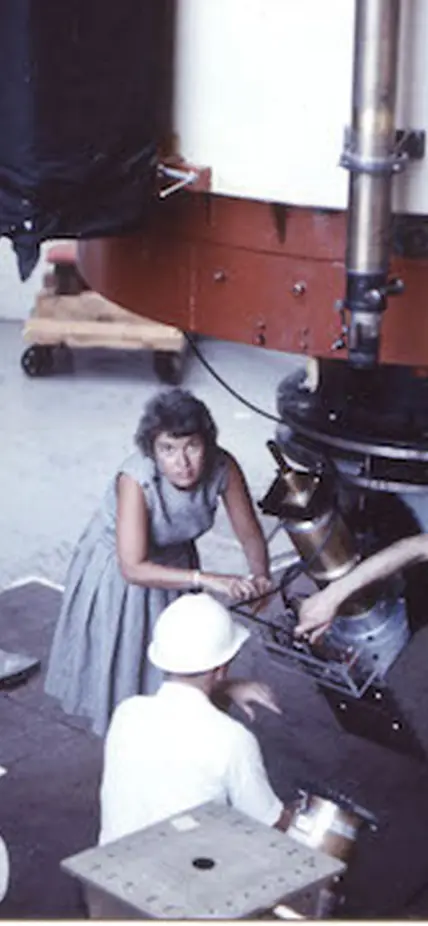Carnegie Science's Mount Wilson Observatory is renowned for groundbreaking discoveries that reshaped our understanding of the cosmos. Yet, amidst the towering telescopes and the celebrated names of male astronomers like George Ellery Hale and Edwin Hubble, there exists a lesser known, but equally important narrative—that of the women of Mount Wilson’s Computing Division, who worked meticulously reducing and analyzing data from astronomical glass plates.
When Carnegie Science established Mount Wilson Observatory in the San Gabriel Mountains overlooking Pasadena in 1904, the field of astronomy was undergoing a transformative period of growth. Advances in technology, particularly the development of large telescopes and the use of photography, revolutionized observational astronomy. And they produced mountains of astronomical data that required skilled personnel to process.
These tasks required precise attention to detail. They came to be assigned primarily to women, often referred to as “computers,” who could be paid less than men and who were thought to possess particular skills, like patience, that made them well-suited to the repetitive work. At Mount Wilson Observatory, and other observatories at the time, professional roles were gendered. Male astronomers would observe overnight in the telescope domes, taking photographs of the sky that would then be reduced by the women of the Computing Division, working at the observatory offices in Pasadena. Men also synthesized and published the ultimate research findings.
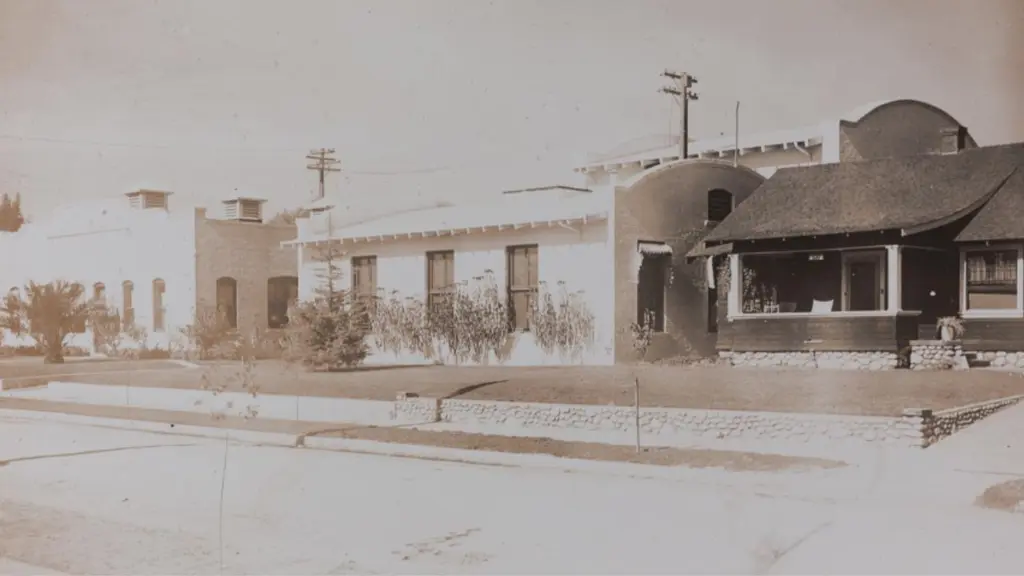
Mount Wilson Observatory offices, circa 1910. At Mount Wilson Observatory professional roles were gendered. Male astronomers would observe overnight in the telescope domes taking photographs of the sky that would then be reduced by women working at the observatory offices in Pasadena. Image Credit: Phoebe Waterman Haas Photo Album [Digital Scans], NASM.2015.0045, National Air and Space Museum, Smithsonian Institution.

Observatory dome of the 60-inch telescope at Mount Wilson Observatory. At Mount Wilson Observatory professional roles were gendered. Male astronomers would observe overnight in the telescope domes taking photographs of the sky that would then be reduced by women working at the observatory offices in Pasadena. Image Credit: Courtesy of the Observatories of the Carnegie Institution for Science Collection at the Huntington Library, San Marino, California.

Mount Wilson Observatory Pasadena office

Mount Wilson Observatory 60-inch telescope
The women of Mount Wilson’s Computing Division, many of whom hailed from then-newly established women’s colleges, were considered part of the Observatory's scientific, or investigatory staff, not office staff, and contributed to the astronomical breakthroughs that were happening at Carnegie.
They worked six days a week measuring the positions and magnitudes of stars, calculating the position and intensity of spectral lines, and counting and measuring sunspots. They also socialized together and had some opportunities for professional development. A delightful photo album kept by computer Phoebe Waterman Hass shows women of the division hiking up Mount Wilson and attending the fourth conference of the International Union for Cooperation in Solar Research hosted on the mountain in 1910.

Four women participants at the 1910 International Union for Co-operation in Solar Research conference held at Mount Wilson Observatory. Phoebe Waterman Haas is pictured on the far left next to Ruth E. Smith. Waterman Haas captioned this photograph “The Four Friends.” Image Credit: Phoebe Waterman Haas Photo Album [Digital Scans], NASM.2015.0045, National Air and Space Museum, Smithsonian Institution.
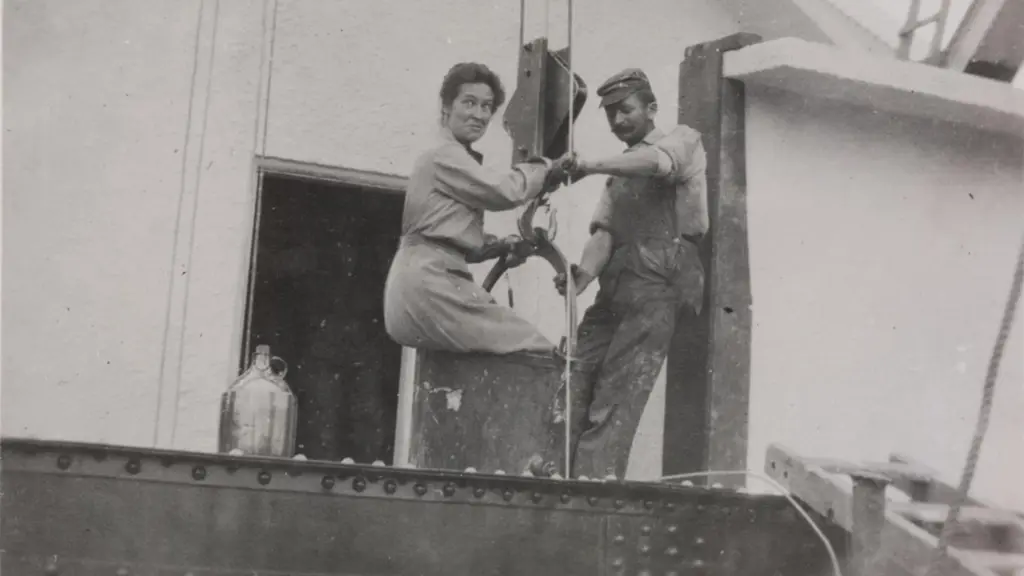
Phoebe Waterman Haas using a bucket lift to ascend the 150-foot solar tower at Mount Wilson Observatory. Waterman Haas captioned this photograph “The start up in the bucket.” Image Credit: Phoebe Waterman Haas Photo Album [Digital Scans], NASM.2015.0045, National Air and Space Museum, Smithsonian Institution.
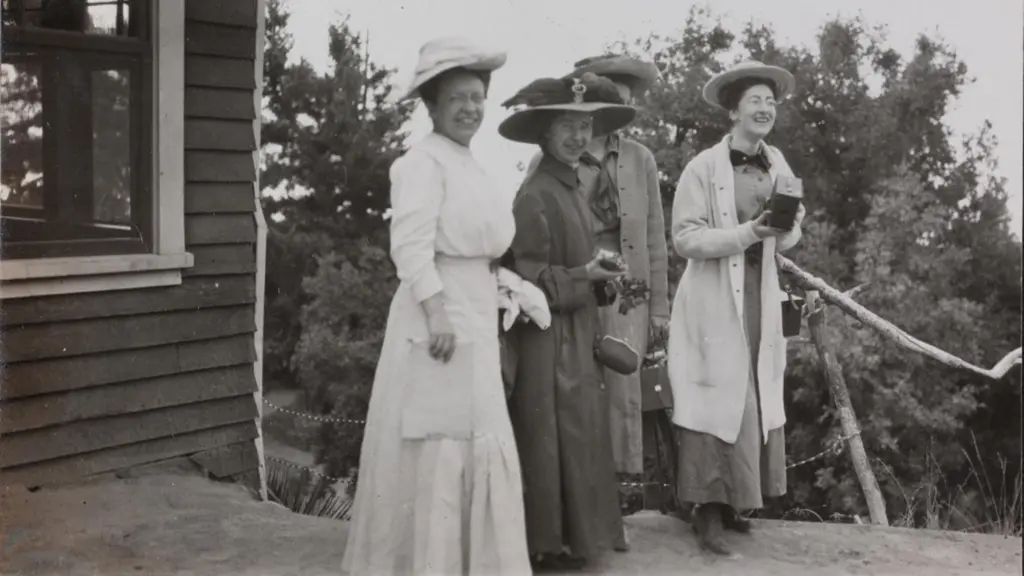
Four women participants at the 1910 International Union for Co-operation in Solar Research conference held at Mount Wilson Observatory. Ruth E. Smith is pictured second from the left and Jennie B. Lasby is pictured on the far right. Image Credit: Phoebe Waterman Haas Photo Album [Digital Scans], NASM.2015.0045, National Air and Space Museum, Smithsonian Institution.

Four women participants at the 1910 International Union for Co-operation in Solar Research held at Mount Wilson Observatory
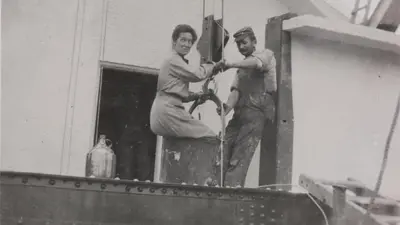
Phoebe Waterman Haas using a bucket lift to ascend the 150-foot solar tower at Mount Wilson Observatory

Four women participants at the 1910 International Union for Co-operation in Solar Research held at Mount Wilson Observatory
Yet, these positions were low-paying and low-status, and the women had almost no opportunity for promotion or freedom to pursue independent research. Women were excluded from observing on Mount Wilson, and the excuse that there was no suitable place for a woman to stay overnight was used into the middle of the century.
Waterman Haas, who worked in the Computing Division from 1909-1911, expressed frustrations that must have been shared by many of her colleagues when she wrote “But oh, I do want so much a position as astronomer, part of my work with the instruments and part with the reduction of my plates, as men here have.” Finding she had gone as far as she could at Mount Wilson, Waterman Haas left the observatory to pursue a Ph.D. in astronomy at Berkeley.
Some women of the Computing Division managed to carve out additional space for themselves. Louise Ware, Mount Wilson Observatory’s first woman “computer,” recruited to the Observatory by founder George Ellery Hale in 1907, co-authored five papers with solar astronomer Charles St. John on topics in solar astrophysics. Ruth E. Smith co-authored a paper on sunspot prominence with visiting astronomer George Abetti and gained responsibility for managing the 5-foot spectroheliograph and photographic darkroom dedicated to solar research. In 1912 Jennie B. Lasby was the first woman to observe with the 60-inch telescope, recorded in logbooks as "assisting" the observer. She would go on to observe more than 50 times, and though she was not credited as a co-author on Walter S. Adams’ publications with which she assisted, she did publish two articles in Popular Astronomy.

A group of women, likely members of the Computing Division of Mount Wilson Observatory, circa 1910-1911. Jennie B. Lasby is pictured on the far left of the back row, Phoebe Waterman Haas is pictured on the right in the middle row, and Ruth E. Smith is pictured on the right in the front row. Waterman Haas captioned this photograph “Before the Laboratory.” Image Credit: Phoebe Waterman Haas Photo Album [Digital Scans], NASM.2015.0045, National Air and Space Museum, Smithsonian Institution.
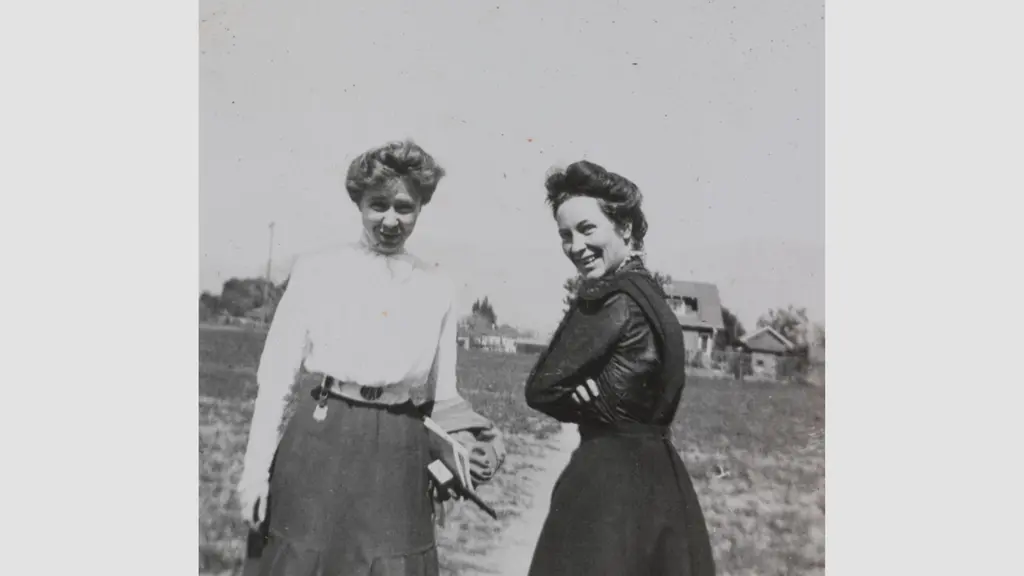
Ruth E. Smith and Phoebe Waterman Haas on their way to work in the Mount Wilson Observatory Computing Division, circa 1910-1911. Waterman Haas captioned this photograph “Going to work.” Image Credit: Phoebe Waterman Haas Photo Album [Digital Scans], NASM.2015.0045, National Air and Space Museum, Smithsonian Institution.
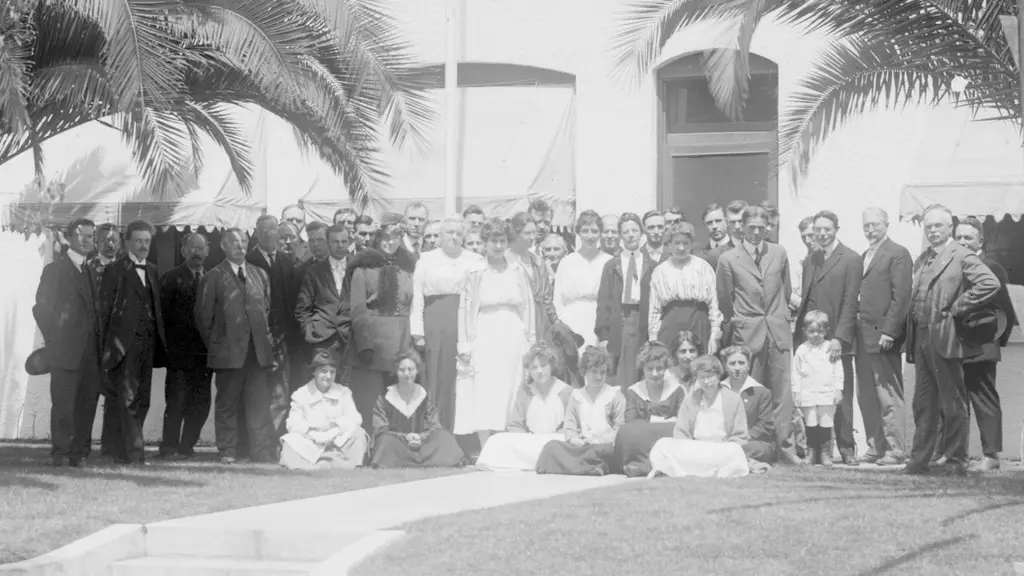
Members of the Mount Wilson Observatory staff, including women of the Computing Division, pose for a group photograph in front of the Observatory's Pasadena office building in 1917. “Computer” Louise Ware is pictured seven from the right in the first standing row wearing a dark jacket and tie. Image Credit: Courtesy of the Observatories of the Carnegie Institution for Science Collection at the Huntington Library, San Marino, California.
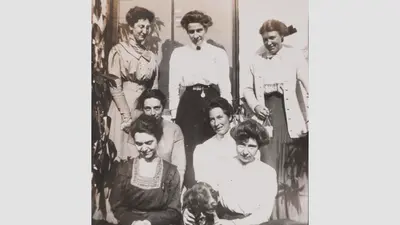
A group of women, likely members of the Computing Division of Mount Wilson Observatory
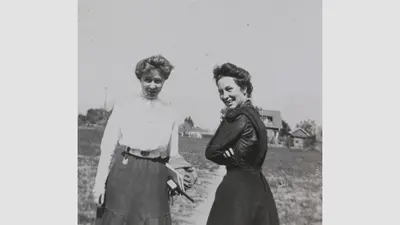
Ruth E. Smith and Phoebe Waterman Haas on their way to work in the Mount Wilson Observatory Computing Division
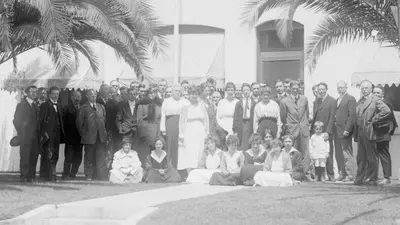
Members of the Mount Wilson Observatory staff, including women of the Computing Division, pose for a group photograph, 1917
Carnegie's archivists continue to seek out more details about these women's vital contributions to our scientific legacy and will continue to spotlight them as new information is uncovered.
The formal Computing Division was disbanded in 1940 and its staff were made members of the research department with which their work was most closely aligned. In the 1960s, modern computing methods replaced the analog work done by human computers, and by the 1980s, no “computing” positions remained at the Carnegie Science Observatories.
The women of Mount Wilson Observatory’s Computing Division were often overlooked and undervalued in their time. They appear in few surviving photographs and are less well documented in published articles and archival records than the Observatory's male astronomers. It is easy to continue to overlook and undervalue their contributions. Yet they were an essential component of the community at Carnegie's Mount Wilson Observatory and played crucial roles in the discoveries made there. Today, it is critical that we recognize the significance of their work, despite the constraints placed upon them, and shine a spotlight on their experiences as an important part of the history of our community.
Bibliography
Ahn, Eun-Joo. Women Scientists at Mount Wilson Observatory During the Early Years. Mount Wilson Observatory.
Fleming, Williamina. A Field for Women’s Work in Astronomy. Speech to the Congress of Astronomy and Astrophysics, World Fair, 1893.
Joskow, Melissa. “More than a Century Ago Astronomer Phoebe Waterman Haas Defied Her Doubters.” Smithsonian Air & Space Magazine, August 2018.
Lankford, John and Ricky L. Slavings. “Gender and Science: Women in American Astronomy, 1859-1940.” Physics Today, March 1990.
Lankford, John. “Women and Women’s Work at Mt. Wilson Observatory before World War II.” In The Earth, the Heavens and the Carnegie Institution of Washington, edited by Gregory A. Good. Washington, DC: American Geophysical Union, 1994.
Mack, Pamela E. “Strategies and Compromises: Women in Astronomy at Harvard College Observatory, 1870-1920.” Journal for the History of Astronomy, 1990.
Mack, Pamela E. “Straying from their Orbits: Women in Astronomy in America” in Women of Science: Righting the Record, edited by G. Kass-Simon and Patricia Farnes, 1990.
Rossiter, Margaret W. “‘Women’s Work’ in Science, 1880-1910.” Isis 71(3), 1980.
Sandage, Allan. Centennial History of the Carnegie Institution of Washington: The Mount Wilson Observatory. New York: Cambridge University Press, 2004.
Trefil, James and Margaret Hindle Hazen. Good Seeing: A Century of Science at the Carnegie Institution of Washington, 1902- 2002. Washington, DC: Joseph Henry Press, 2002.
Wehrey, Catherine. “Women Computing the Stars.” Verso: Blog of the Huntington Library, Art Museum and Botanical Garden, 2015.
Zrull, Lindsay Smith “Women in Glass: Women at the Harvard Observatory during the Era of Astronomical Glass Plate Photography, 1875–1975.” Journal for the History of Astronomy, 52(2), 2021.

